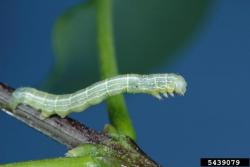Both of these insects are native to North America. As immatures or caterpillars, these insects are known as inchworms. As an adult, they become moths. Both, as caterpillars, have elongate and cylindrical bodies and a well developed head capsule with 3 pairs of thoracic legs. The spring cankerworm has 2 pairs of fleshy abdominal legs (known as prolegs) whereas the fall cankerworm has 3 pairs of prolegs which may be termed 2.5 pairs due to the shortened length of the set closest to the head. Fall cankerworm larvae can vary in color from light green with white lines from the head to the tip of the abdomen to dark brownish-green in color with a black stripe down the length of the back. Spring cankerworm larvae may also be green to darker in color. Both are capable of dispersing through ballooning, or using a silken thread to carry themselves to new host plants on the wind. Eggs hatch at the same time in the spring, approximately mid-May in Massachusetts. Both species may be seen feeding together on the same hosts until roughly the end of June. Pupation occurs at that time, when caterpillars drop to the soil and spin a cocoon. Adults of the spring cankerworm are active in February into March while fall cankerworm adults are active in late November into early December and sometimes January. Males of both species are able to fly (dull-colored, small moths) whereas females of both are wingless and cannot fly. Adults mate and the female fall cankerworm will lay eggs in aligned masses of 100 on small twigs whereas female spring cankerworm will lay spindle-shaped eggs in masses of 100 in the rough bark of larger branches or the trunk of the host plant. These two species are often found feeding on the same host plant, together.
Both the spring and fall cankerworms begin feeding at bud break, often in mixed populations. Larvae can devour all but the midrib of the leaf and completely defoliate their hosts. Leaves may also appear shredded or tattered.
Monitor host plants that have had issues with cankerworms in the past for adult activity and eggs. Leaves/branches exhibiting potential cankerworm damage on susceptible hosts can be tapped, thus encouraging the caterpillars to drop from the branches on a silken thread. Look for clusters of caterpillars feeding together.
Banding tree trunks just before the time period that the females of each species are active may be used for monitoring purposes, but may not achieve the desired level of management.
As these two species are native to North America, bacterial and viral diseases help regulate their populations naturally. There are also important egg and larval parasites present in their populations.
There are multiple species of parasitic wasp (including Aleiodes geometrae, Telenomus alsophilae, Euplectrus mellipes, and Trichogramma minutum) that attack cankerworm eggs. Other insects such as ground beetles, birds, and small rodents also prey on cankerworms. Typically these factors keep populations beneath damaging levels.
For spring cankerworm, Rogas geometrae, Apanteles paleacritae, Meteorus hyphantriae, Phobcampe geometrae, and Hyposoter fuscitarsis are all known parasitoids of that species (Van Driesche et al., 2013).
Abamectin (NL)
Acephate (NL)
Acetamiprid (L)
Azadirachtin (NL)
Bacillus thuringiensis subsp. aizawai (L)
Bacillus thuringiensis subsp. kurstaki (NL)
Beauveria bassiana (NL)
Bifenthrin (NL)
Carbaryl (L)
Chlorantraniliprole (NL)
Chlorpyrifos (N)
Chromobacterium subtsugae (NL)
Cyantraniliprole (NL)
Cyfluthrin (NL)
Deltamethrin (L)
Emamectin benzoate (L)
Flonicamid+cyclaniliprole (N)
Gamma-cyhalothrin (L)
Horticultural oil (L)
Lambda-cyhalothrin (L)
Methoxyfenozide (NL)
Neem oil (NL)
Permethrin (L)
Pyrethrins (L)
Pyrethrin+sulfur (NL)
Spinetoram+sulfoxaflor (N)
Spinosad (NL)
Tau-fluvalinate (NL)
Tebufenozide (NL)
Zeta-cypermethrin (L)
A dormant oil application may kill the eggs of both species on the host plant, however thorough coverage is necessary. Fall cankerworm adults lay eggs in late November/early December. Spring cankerworms lay eggs from late February to early March.
Active ingredients that may be applied systemically include: acephate (injection), acetamiprid (injection), azadirachtin (injection, soil drench), cyantraniliprole (soil drench, soil injection), emamectin benzoate (injection), and neem oil (soil drench).
When used in nurseries, chlorpyrifos is for quarantine use only.
Make insecticide applications after bloom to protect pollinators. Applications at times of the day and temperatures when pollinators are less likely to be active can also reduce the risk of impacting their populations.
Note: Beginning July 1, 2022 neonicotinoid insecticides are classified as state restricted use for use on tree and shrub insect pests in Massachusetts. For more information, visit the MA Department of Agricultural Resources Pesticide Program.

